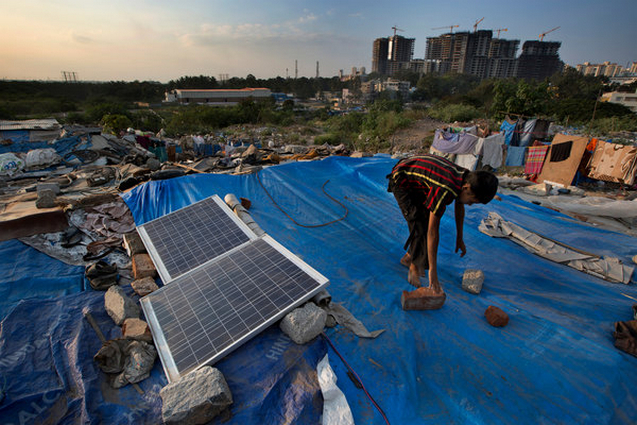 |
Solar panels on the roof of a shop in a settlement in Bangalore, India. Kuni Takahashi for The New York Times
|
MUMBAI, India — Just a few years ago, the world watched nervously as India went on a building spree of
coal-fired power plants, more than doubling its capacity and claiming
that more were needed. Coal output, officials said, would almost triple,
to 1.5 billion tons, by 2020.
India’s plans were
cited by American critics of the Paris climate accord as proof of the
futility of advanced nations trying to limit their carbon output. But
now, even as President Trump pulls the United States out of the pact,
India has undergone an astonishing turnaround, driven in great part by a
steep fall in the cost of solar power.
Experts
now say that India not only has no need of any new coal-fired plants
for at least a decade, given that existing plants are running below 60
percent of capacity, but that after that it could rely on renewable
sources for all its additional power needs.
Rather than building coal-fired plants, it is now canceling many in the early planning stages. And last month, the government lowered its annual production target for coal to 600 million tons from 660 million.
The sharp reversal, welcome news to world leaders trying to avert the potentially deadly effects of global warming,
is a reflection both of the changing economics of renewable energy and a
growing environmental consciousness in a country with some of the worst
air pollution in the world.
What
India does matters, because it is the world’s third-largest emitter of
greenhouse gases, behind China and the United States. And its energy
needs are staggering — nearly one-quarter of its population has no
electricity and many others get it only intermittently.
With
India’s power needs expected to grow substantially as its economy
continues to expand, its energy use will heavily influence the world’s
chances of containing the greenhouse gases that scientists believe are
driving global warming.
Much attention at the time
of the signing of the Paris agreement was focused on the role President
Barack Obama played in pushing India’s prime minister, Narendra Modi,
to sign. In doing so, Mr. Modi committed India to achieving 40 percent
of its electricity capacity from nonfossil-fuel sources by 2030.
 |
Workers at a coal-fired power plant under construction in Kudgi, India, in 2015. Aijaz Rahi / Associated Press
|
Less understood was Mr. Modi’s longstanding personal
commitment to taking India in a greener direction. That has been
strengthened in recent years by growing evidence that a greener path
makes political and economic sense as well, says Harsh Pant, a fellow at
the Observer Research Foundation, a New Delhi-based research
organization.
“Modi’s constituency is the middle
class, and the middle class in Indian cities is choking on pollution,”
Mr. Pant said. “Modi knows climate change is good politics. Climate
change makes sense to Modi because he believes it as it is good
economics and politics.”
Two major economic
factors lie at the heart of India’s move away from coal. The first is
that the country’s growth rate, while faster than that of most major
economies, slipped to 6.1 percent for the most recent quarter,
down from 7 percent in the previous quarter. And much of that growth
has come in service industries rather than in power-hungry
manufacturing.
Equally
important is the startling drop in the price of renewable energy
sources. Many energy experts say renewables are poised to become a less
expensive alternative to coal within the next decade.
“The
train has left the station. Mr. Trump has come too late” to slow the
transition to renewable energy, said Ajay Mathur, director general of the Energy Resources Institute,
a New Delhi policy center closely associated with the government. “By
the time the coal-fired plants come up to full capacity because of
increasing demand, the price of renewables will be lower than the price
of coal.”
Based on December data
from the Central Electric Authority, Mr. Mathur’s institute reported in
March that India might be able to meet its additional power needs in
the future with renewable energy.
It based that
prediction on the remarkable drop in the cost of solar power. In
approving proposals for new solar power plants, the Indian government
seeks bids from prospective builders who compete to pledge the lowest
price at which they anticipate selling power.
Five
years ago, the lowest bid came in at 7 rupees, or 11 cents, per
kilowatt-hour. In early May, the lowest bidder came in at less than half
of that price, or 2.44 rupees per kilowatt-hour, a little under 4
cents, experts here say.
The latest bid makes solar power less expensive than coal, which sells for about 3 rupees per kilowatt-hour.
 |
Smog enveloping buildings on the outskirts of New Delhi in November 2014. Roberto Schmidt / Agence France-Presse — Getty Images
|
Storage costs, a critical component of renewable
energy systems, have also fallen. “The crucial question has been, ‘Yes,
but what do you do when the wind doesn’t blow and the sun doesn’t
shine?’” said Adair Turner, the chairman of the Energy Transitions Commission, which studies climate issues.
The
cost of lithium ion batteries, the gold standard in solar power
storage, has fallen significantly, Mr. Turner said, largely because of
economies of scale. Where the price was about $1,000 per kilowatt-hour
more than five years ago, it is now $273 and dropping, Mr. Mathur said.
The
price needs to fall to $100 per kilowatt-hour for renewable energy to
be comparable in price to coal, Mr. Mathur says. Mr. Turner thinks that
will happen far sooner than the year 2030, which his group had been
predicting.
“To be blunt, the success of this has
been bigger than I certainly realized,” Mr. Turner said. “There were
people who were optimists, and it’s the optimists who have won out.”
New
Delhi had long argued that it was hypocritical of Western nations that
have burned fossil fuels for centuries to ask Indians to sacrifice their
growth to cope with the effects. But the Modi administration has set
ambitious targets for a greener Indian future.
The
government pledged in 2015, when the country’s electricity capacity
from renewables was 36 gigawatts, to increase it to 175 gigawatts by
2022.
Piyush Goyal, India’s power minister, announced in a speech in late April that the country would take steps to assure that by 2030 only electric cars would be sold.
“That’s
rather ambitious,” Rahul Tongia, a fellow at Brookings India, said.
“The targets are there. The vision is there. The question is: ‘Is it
going to happen? How?’”
The Indian government’s policy research arm, the National Institution for Transforming India, or NITI Aayog, recently released a report in collaboration with the Rocky Mountain Institute
in Boulder, Colo., that calculated India could save $60 billion and
reduce its projected carbon emissions by 37 percent by 2030 if it
adopted widespread use of electric vehicles and more public
transportation.
 |
A street scene in the old Hyderabad city in India. Atul Loke for The New York Times
|
Mr. Mathur says that even if India falls short of
those ambitious goals, just coming close will have a huge impact on the
concentration of greenhouse gases in the world and pollution within the
country.
“Even a year and a half ago, I didn’t
expect we would go out on a limb and say electric vehicles are a public
policy goal for us. It is truly exciting,” he said in an interview.
Besides
reducing the choking pollution in India’s cities, moving to electric
vehicles also makes sense because the country has excess generation
capacity in the underused coal-fired plants and is too heavily reliant
on petroleum imports, which present a geopolitical risk.
“There
has for a very long time been a push to reduce the growth in imports,”
Mr. Mathur said. “This is one of those perfect policy opportunities,
with short-term and long-term benefits.”
Navroz
Dubash, a fellow at the Center for Policy Research in New Delhi,
cautions that even though India is likely to meet its additional energy
needs in the future from renewable sources, that does not mean India is
about to stop burning coal tomorrow.
“It
is important not to draw from this that India’s tryst with coal is
necessarily done,” Mr. Dubash said, “just that there are signs it will
end sooner and at a lower level than expected.”
India canceled 13.7 gigawatts of proposed coal-fired power plants last month alone, the Institute for Energy Economics and Financial Analysis said.
The government has admitted that an additional 8.6 gigawatts of
coal-fired generation capacity built at a cost of $9 billion is
potentially no longer financially viable because of competition from
renewable sources, the institute said.
This is
hopeful news for the world, said Mr. Tongia, because the only way for
the world not to grow too warm is for “developing countries, especially
India, to do more, to come in lower than budget, to do their unfair
share.”
And, Mr. Tongia said, “the good news” is that India has decided that it is in its interest to do its “unfair share.”

No comments :
Post a Comment